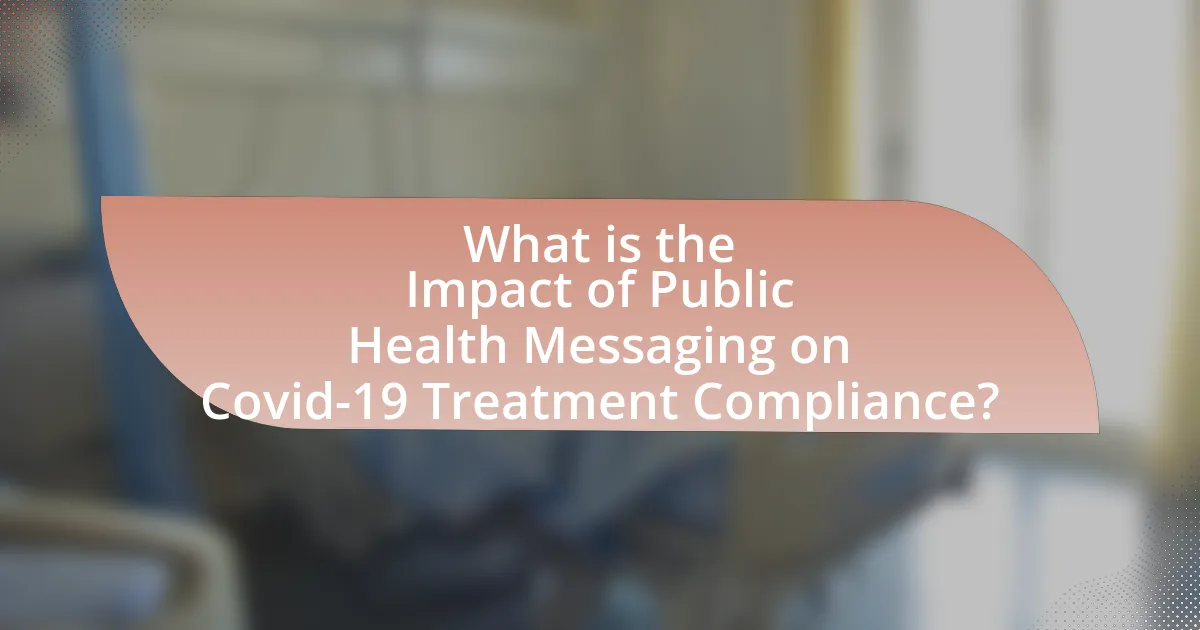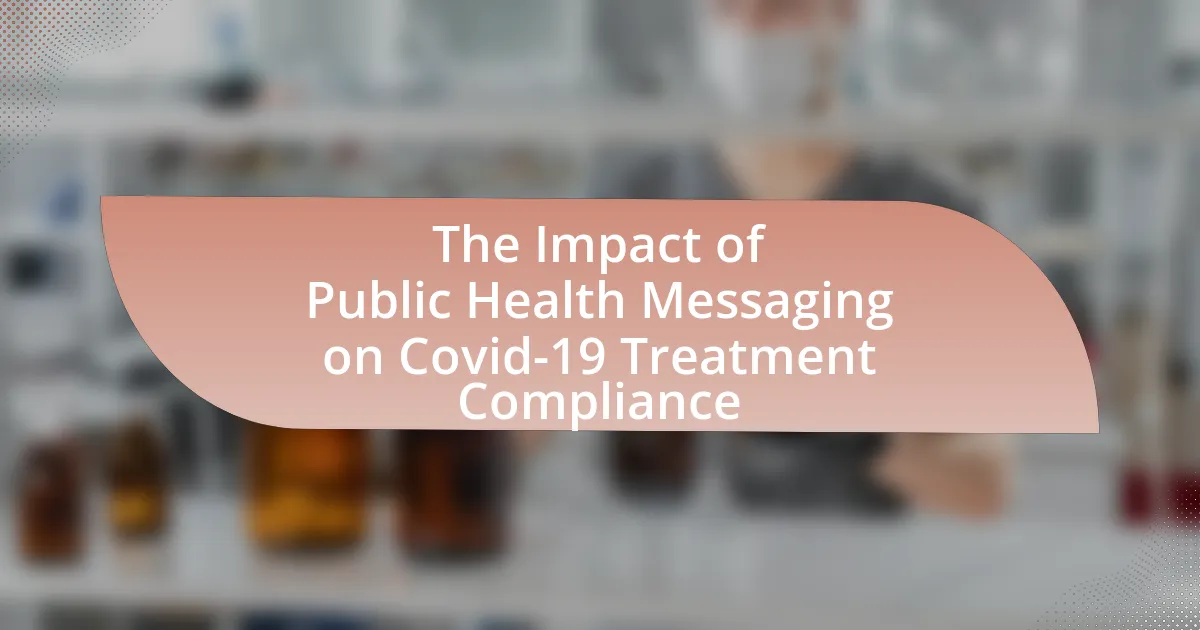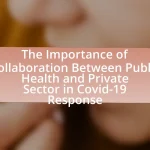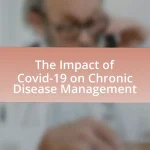The article examines the impact of public health messaging on Covid-19 treatment compliance, highlighting how effective communication strategies influence public perceptions and behaviors regarding health guidelines. It discusses the key elements of successful messaging, including clarity, credibility, empathy, and actionable guidance, and their correlation with increased compliance rates. The article also explores the role of demographics in shaping the effectiveness of health messages, the consequences of non-compliance, and the importance of tailored communication strategies to reach diverse populations. Additionally, it addresses the challenges faced in public health messaging during the pandemic, including misinformation and barriers to reaching vulnerable groups, while offering best practices for enhancing message effectiveness.

What is the Impact of Public Health Messaging on Covid-19 Treatment Compliance?
Public health messaging significantly influences Covid-19 treatment compliance by shaping public perceptions and behaviors regarding health guidelines. Effective communication strategies, such as clear messaging about the importance of vaccination and adherence to treatment protocols, have been shown to increase compliance rates. For instance, a study published in the journal “Health Affairs” found that communities exposed to consistent and transparent public health messaging experienced higher vaccination rates and better adherence to treatment recommendations. This correlation underscores the critical role of targeted public health campaigns in enhancing compliance during the pandemic.
How does public health messaging influence patient behavior during the Covid-19 pandemic?
Public health messaging significantly influences patient behavior during the Covid-19 pandemic by shaping perceptions and encouraging compliance with health guidelines. Clear and consistent messaging from health authorities, such as the World Health Organization and the Centers for Disease Control and Prevention, has been shown to increase public awareness about the importance of preventive measures like mask-wearing and vaccination. For instance, a study published in the journal Health Affairs found that effective communication strategies led to a 20% increase in mask usage among the population. This demonstrates that well-crafted public health messages can directly impact individual behaviors, leading to improved adherence to recommended health practices during the pandemic.
What are the key elements of effective public health messaging?
The key elements of effective public health messaging include clarity, credibility, empathy, and actionable guidance. Clarity ensures that the message is easily understood, which is crucial for public compliance, especially during health crises like Covid-19. Credibility is established through trusted sources, such as health organizations and experts, which enhances the message’s acceptance. Empathy addresses the audience’s concerns and emotions, fostering a connection that encourages adherence to health guidelines. Actionable guidance provides specific steps that individuals can take, making it easier for them to comply with public health recommendations. Research has shown that messages incorporating these elements significantly improve compliance rates, as evidenced by studies conducted during the Covid-19 pandemic, which highlighted the importance of clear and empathetic communication in increasing treatment adherence.
How do different messaging strategies affect treatment compliance?
Different messaging strategies significantly influence treatment compliance by shaping patients’ understanding and attitudes towards their health. For instance, clear, concise, and empathetic messaging has been shown to enhance compliance rates, as evidenced by a study published in the Journal of Health Communication, which found that patients who received tailored messages about their treatment were 30% more likely to adhere to prescribed regimens compared to those who received generic information. Additionally, strategies that incorporate reminders and motivational support have been linked to improved adherence, with research indicating that SMS reminders can increase compliance by up to 25%. Thus, the effectiveness of messaging strategies directly correlates with the level of treatment compliance observed in patients.
Why is treatment compliance critical in managing Covid-19?
Treatment compliance is critical in managing Covid-19 because it directly influences the effectiveness of therapeutic interventions and public health outcomes. Adherence to prescribed treatments, such as antiviral medications and vaccination schedules, ensures that individuals achieve optimal health benefits and reduce the risk of virus transmission. Studies indicate that high compliance rates can lead to a significant decrease in hospitalizations and mortality rates associated with Covid-19. For instance, a report from the Centers for Disease Control and Prevention (CDC) highlights that consistent adherence to vaccination protocols can reduce severe disease by up to 95%. Therefore, treatment compliance is essential for controlling the spread of Covid-19 and protecting public health.
What are the consequences of non-compliance with Covid-19 treatment protocols?
Non-compliance with Covid-19 treatment protocols can lead to severe health consequences, including increased transmission of the virus, prolonged illness, and higher mortality rates. When individuals do not adhere to prescribed treatments, they risk not only their own health but also the health of others, as untreated cases can contribute to community spread. Studies have shown that adherence to treatment protocols significantly reduces the likelihood of severe outcomes; for instance, a report from the Centers for Disease Control and Prevention indicated that proper treatment adherence can lower hospitalization rates by up to 50%. Additionally, non-compliance can strain healthcare systems, leading to increased costs and resource allocation challenges.
How does treatment compliance impact public health outcomes?
Treatment compliance significantly improves public health outcomes by enhancing the effectiveness of medical interventions and reducing disease transmission. When individuals adhere to prescribed treatment regimens, such as vaccinations or antiviral medications, the overall health of the community improves, leading to lower rates of morbidity and mortality. For instance, studies have shown that high compliance with COVID-19 vaccination protocols correlates with decreased infection rates and hospitalizations, thereby alleviating the burden on healthcare systems. Additionally, the World Health Organization reported that increased treatment adherence can lead to a 50% reduction in the spread of infectious diseases, underscoring the critical role of compliance in achieving public health goals.
What role do demographics play in the effectiveness of public health messaging?
Demographics significantly influence the effectiveness of public health messaging by determining how different groups perceive and respond to health information. For instance, age, gender, education level, and socioeconomic status can affect individuals’ understanding, trust, and compliance with health directives. Research indicates that tailored messaging, which considers these demographic factors, leads to higher engagement and adherence rates. A study published in the Journal of Health Communication found that messages designed for specific demographic groups resulted in a 30% increase in compliance with COVID-19 guidelines among targeted populations. This evidence underscores the necessity of demographic awareness in crafting effective public health communications.
How do age, gender, and socioeconomic status affect treatment compliance?
Age, gender, and socioeconomic status significantly influence treatment compliance. Younger individuals often exhibit lower compliance rates due to factors like perceived invulnerability and lifestyle distractions, while older adults tend to adhere more closely to treatment regimens, as evidenced by studies showing that adherence increases with age. Gender differences also play a role; research indicates that women generally demonstrate higher compliance than men, potentially due to greater health awareness and proactive health-seeking behaviors. Socioeconomic status further impacts compliance, with individuals from lower socioeconomic backgrounds facing barriers such as limited access to healthcare resources, financial constraints, and lower health literacy, which can lead to decreased adherence to treatment protocols. For instance, a study published in the Journal of Health Economics found that individuals with lower income levels were 30% less likely to follow prescribed treatment plans compared to their higher-income counterparts.
What demographic factors influence the reception of public health messages?
Demographic factors that influence the reception of public health messages include age, education level, socioeconomic status, and cultural background. Research indicates that younger individuals are more likely to engage with digital health messages, while older adults may prefer traditional media. Additionally, higher education levels correlate with better understanding and compliance with health messages, as individuals with more education tend to have greater health literacy. Socioeconomic status affects access to information and resources, impacting how messages are received and acted upon. Cultural background shapes perceptions and beliefs about health, influencing the effectiveness of messaging strategies. For instance, a study published in the Journal of Health Communication found that culturally tailored messages significantly improved health outcomes among diverse populations.
How can public health messaging be improved to enhance treatment compliance?
Public health messaging can be improved to enhance treatment compliance by utilizing clear, concise, and culturally relevant communication strategies. Research indicates that messages tailored to specific demographics, incorporating local languages and cultural references, significantly increase understanding and adherence. For instance, a study published in the Journal of Health Communication found that culturally adapted messages led to a 30% increase in treatment compliance among minority populations during the Covid-19 pandemic. Additionally, employing multiple communication channels, such as social media, community outreach, and healthcare provider engagement, ensures broader reach and reinforces the message.
What strategies can be implemented to tailor messages for diverse populations?
To tailor messages for diverse populations, public health officials can implement strategies such as cultural adaptation, language translation, and community engagement. Cultural adaptation involves modifying messages to align with the values, beliefs, and practices of specific groups, which enhances relatability and effectiveness. Language translation ensures that information is accessible to non-English speakers, thereby increasing comprehension and compliance. Community engagement fosters trust and collaboration by involving local leaders and organizations in message dissemination, which has been shown to improve public health outcomes. For instance, a study published in the American Journal of Public Health found that culturally tailored interventions significantly increased vaccination rates among minority populations during the COVID-19 pandemic.
How can feedback from the community shape future public health messaging?
Feedback from the community can significantly shape future public health messaging by ensuring that communication strategies are tailored to the needs and concerns of the population. When public health officials gather input from community members, they can identify misconceptions, cultural sensitivities, and specific barriers to compliance that may not be apparent through traditional data collection methods. For instance, during the COVID-19 pandemic, studies indicated that communities that engaged in two-way communication with health authorities reported higher compliance rates with health guidelines, as messages were more relevant and resonated better with the audience. This approach not only enhances the effectiveness of public health campaigns but also fosters trust and collaboration between health officials and the community, ultimately leading to improved health outcomes.
What are the challenges faced in public health messaging during the Covid-19 pandemic?
Public health messaging during the Covid-19 pandemic faced significant challenges, primarily due to misinformation, varying public perceptions, and inconsistent messaging from authorities. Misinformation spread rapidly through social media, leading to confusion and skepticism about health guidelines. For instance, a study published in the Journal of Medical Internet Research found that 45% of respondents reported encountering false information about Covid-19, which undermined trust in official messages. Additionally, public perceptions varied widely based on demographics and political affiliations, complicating the effectiveness of uniform messaging. Inconsistent communication from health authorities, such as differing recommendations on mask-wearing and vaccination, further contributed to public uncertainty and compliance issues. These factors collectively hindered the ability to convey clear and actionable health information, impacting overall treatment compliance during the pandemic.
How do misinformation and disinformation affect treatment compliance?
Misinformation and disinformation significantly reduce treatment compliance by creating confusion and distrust among patients regarding medical advice. Studies indicate that when patients encounter false information about treatments, they are less likely to follow prescribed regimens, leading to poorer health outcomes. For instance, a survey conducted by the Pew Research Center found that 47% of Americans reported encountering conflicting information about COVID-19 treatments, which directly influenced their willingness to adhere to medical recommendations. This erosion of trust in healthcare guidance can result in increased hospitalizations and prolonged illness, demonstrating the critical need for accurate public health messaging.
What barriers exist in reaching vulnerable populations with health messages?
Barriers in reaching vulnerable populations with health messages include language differences, lack of access to technology, and socioeconomic factors. Language differences hinder effective communication, as many vulnerable individuals may not speak the dominant language used in health messaging. Lack of access to technology, such as smartphones or the internet, limits the ability of these populations to receive digital health information. Socioeconomic factors, including low income and education levels, can also impede understanding and compliance with health messages, as individuals may prioritize immediate needs over health information. Research indicates that these barriers contribute to disparities in health outcomes, particularly during public health crises like the COVID-19 pandemic.
What best practices can be adopted for effective public health messaging?
Effective public health messaging can be achieved by ensuring clarity, consistency, and cultural relevance. Clarity involves using simple language and avoiding jargon, which helps the audience easily understand the message. Consistency across various platforms and messages reinforces trust and reduces confusion, as evidenced by the World Health Organization’s guidelines during the COVID-19 pandemic, which emphasized uniform messaging to enhance public compliance. Cultural relevance ensures that messages resonate with diverse communities, as demonstrated by targeted campaigns that address specific cultural beliefs and practices, leading to increased engagement and adherence to health guidelines.
How can technology be leveraged to improve message dissemination?
Technology can be leveraged to improve message dissemination by utilizing digital platforms and data analytics to reach wider audiences effectively. For instance, social media channels enable real-time communication and targeted messaging, allowing public health organizations to disseminate crucial information about Covid-19 treatment compliance to specific demographics. According to a study published in the Journal of Medical Internet Research, 80% of individuals reported receiving health information through social media, highlighting its effectiveness in reaching diverse populations. Additionally, mobile applications can facilitate personalized notifications and reminders, enhancing adherence to treatment protocols. The integration of these technologies not only broadens the reach but also tailors the messaging to meet the needs of various groups, thereby improving overall compliance rates.
What role do partnerships with community organizations play in enhancing message effectiveness?
Partnerships with community organizations significantly enhance message effectiveness by leveraging local trust and networks to disseminate information. These organizations often have established relationships with community members, which can facilitate greater engagement and receptivity to public health messages. For instance, a study published in the American Journal of Public Health found that community-based interventions during the COVID-19 pandemic led to increased compliance with health guidelines, demonstrating that messages delivered through trusted local entities were more impactful than those from external sources. This localized approach not only improves message credibility but also tailors communication to meet the specific cultural and social contexts of the community, further enhancing understanding and compliance.
What practical tips can enhance public health messaging for Covid-19 treatment compliance?
Practical tips to enhance public health messaging for Covid-19 treatment compliance include using clear, concise language, leveraging multiple communication channels, and tailoring messages to specific audiences. Clear language ensures that the information is easily understood, which is crucial for compliance; studies show that simplified messaging increases comprehension and adherence. Utilizing various channels, such as social media, television, and community outreach, maximizes reach and engagement, as diverse populations consume information differently. Tailoring messages to specific demographics, including age, cultural background, and health literacy, ensures relevance and resonance, which can significantly improve compliance rates. For instance, targeted campaigns have been shown to increase vaccination rates among specific groups by addressing their unique concerns and barriers.


